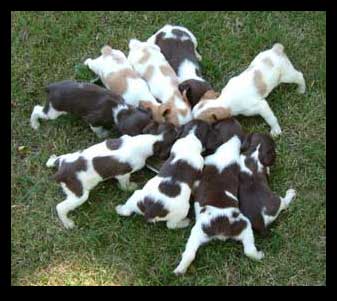
HOME
Our Brittanys
About Shelley
About Candice
About Darren
Dog Boarding
Ataboy Store
Brittany Puppies
Photo Gallery
Life At Ataboy Photos
Choosing A Brittany Breeder
Contact Info.
Customer Comments
Brittany Puppies 1st Year
Brittany Breed Standard
Brittany Breed History
Brittany Dog Title Meanings
Brittany Dog Treat Recipes
FAQ
Kids Page
Our Horses
Brittany Puppy Names
Links & Webrings
Web Site Awards

Most dry dog foods contain 18% to 27% protein, 7% to 15% fat, less than 12% moisture and 35% to 50% carbohydrate (also expressed as N.F.E. or nitrogen-free extract). These diets deliver between 1,400 and 2,000 metabolizable kilocalories per pound of product.
In addition to distinguishing pet foods based on their form, products are also distinguished more generally based on the criteria of cost, place of purchase, nutrient density (number of calories per pound) and, to a lesser degree, palatability and digestibility. Super premium, premium and non-premium products can all offer 100% complete and balanced nutrition. No official definitions exist for these categories of pet foods and the characteristics of products vary from one manufacturer to another. In general, super premium products tend to be at the high end of the spectrum for the distinguishing characteristics, premium products fall in the mid-range and non-premium products tend toward the lower end of the spectrum for cost and nutrient density. Super premium foods are generally sold in pet specialty stores and veterinary offices, and usually have more calories per pound of food. Premium foods are traditionally sold at grocery stores but are also available in pet specialty outlets. These types of products are moderately priced. Grocery stores, most pet stores, department type stores and feed stores often carry non-premium pet foods which are very inexpensive.
Some pet foods are designed with palatability as their distinguishing feature. These products often have kibbles with different sizes and shapes and carry various flavor claims. They appeal to pet owners interested in indulging their pet and providing great variety.
Store-brand products are those
pet foods sold under the store's name as opposed to a national brand name.
These foods are designed to offer similar guarantees, ingredients and
performance to the nationally advertised brands at a lower price.
The difference in moisture content and ingredients and order of ingredients
among the various types of pet food impacts the nutrient density of the
products or the amount of nutrients per pound of food. As the water content
and the filler content of the diet increases, the amount of protein, fat
and other essential nutrients decreases. That means the animal must consume
a larger portion of the high moisture products to receive the nutrition
they need.
All ingredients used in manufacture of the pet food shall be listed in
the ingredient list on the label. The ingredients shall be listed in descending
order of predominance by pre-cooked weight. Therefore, the highest percentage
of what is in the bag
must be listed first. If Beef is listed as the first ingredient than Beef
is the highest
percentage of what is in the bag. The same would apply if Ground Yellow
corn
was listed first. The top 3 ingredients make up 75% of what is contained
in the bag of dog food.
Dogs are not vegetarians! Dogs bodies can more readily use protein contained
in real meat than they can in vegetable matter. Dog food should not contain
artificial chemicals to preserve the food. These are proven to be cancer
causing.
When feeding a dog a food that begins with ingredients other than real
meat as
the number one ingredient you will find that you need to feed your dog
a larger
quantity of that food in order for the dog to be able to receive it's
daily intake
requirements. In other words if you need to feed your dog 4 cups of brand
x a day
by a premium food you'll (depending on breed of dog) you'll probably
only need to feed 2 cups per day. Now less in means less out the other
end. Also, that brand x that you thought was such a bargain is not.